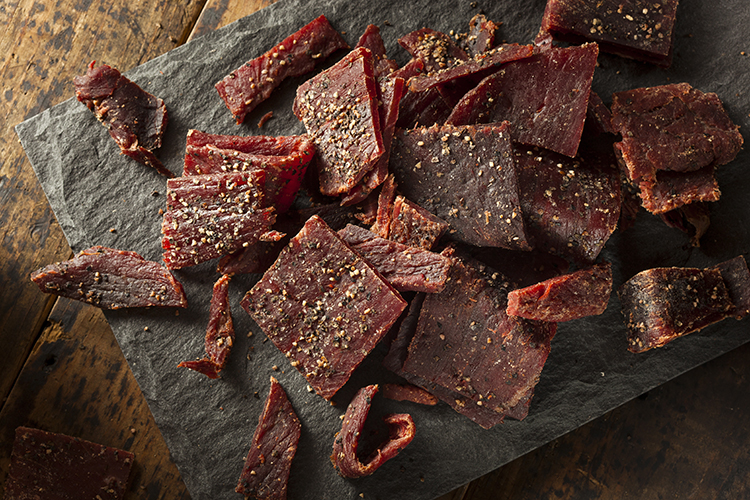The first meat snacks were consumed thousands of years ago, as travelers tucked dried meats into camel or horse saddles for nourishment during long journeys. Flash forward a millennium or two, and meat snacks in many different forms and flavors are being tossed into backpacks or pulled from pantries for between-meal sustenance.
The appeal of portability, nutrition in the way of protein and satiety has led to meat snacks keeping a wide appeal. Dollar sales of meat snacks experienced a 4.8% compound growth rate over the past four years, according to data from Nielsen. Research from Technavio projects global sales of meat snacks could reach $9.47 billion by 2021.
If sales are solid, so is the consumer base. Underscoring the perennial appeal of this type of product, younger consumers savor meat snacks as much as older consumers. Recent information from CarbonView Research, for example, shows that meat snacks are one of the top four food items that millennials buy in convenience stores.
A Nation of Noshers
|
The Meat of the Matter
Practicality has long driven the consumption of meat snacks. Many meat snacks are available in handy grab-and-go packaging, which aligns with consumer interest in portion control. At the same time, with more families at home together and fewer activities necessitating on-the-go consumption, there is a desire for larger package sizes and multi-packs. During the stock-up period of the pandemic this spring, dollar sales of snack package sizes in the 10-ounce to 16-ounce range grew 87 percent, according to data from market research firm IRI.
Beyond convenience and functionality, there are other reasons why meat snacks are a core category in the overall snack food market. Strong interest in high protein and paleo diets over the past few years is a factor in the current collective craving for meat snacks. A category review of meat snacks released in December 2019 by Innova Market Insights ties meat snack consumption to rising demand for high-protein, low-fat foods; Innova’s research found that the leading positioning of meat snacks in 2019 was centered on the products’ protein-rich profile.
Clean and Clear
Limited and clean labels are a built-in strength for the meat snacks category. The term “natural” is the most influential claim among food-buying consumers. (Source: 2020 Food and Health Survey, International Food Information Council)
- Limited and clean labels are a build-in strength for the meat snacks category The term “natural” is the most influential claim among food-buying consumers. (Source: 2020 Food and Health Survey, International Food Information Council)
- 41% of U.S. consumers actively seek out products with natural ingredients. Almost half of those are millennials, but nearly 30% are buyers over age 55. (Source: Charleston|Orwig)
- More than 60% of global consumers say that 100% natural products are important because they are healthier, and 51% say they are better for them. (Source: FMCG Gurus)
To help meat processors respond to market demand for snack products with more natural ingredients, Corbion offers a number of vinegar- and ferment-based solutions for mold control and improved yield under its Verdad® brand, including Verdad Powder N20, Verdad Powder N30 and Verdad Opti Powder XM10. Corbion’s celery powder is another viable, appealing solution for products with limited and clean labels.
Now Trending
For something as simple as cured meat with seasonings, the array of meat snacks offered on the market is broad and varied. Stalwarts like meat sticks, pork rinds and beef jerky remain favorites, but there’s room for new favorites made with different cuts of protein, formats and ingredients that deliver on flavor and natural profiles that people find appealing.
At a premium: Meat snacks may be linked to impulse buys at c-stores, checkout lines and ball games, but as the market has expanded, it has also been elevated. According to the Innova report on meat snacks, premium and indulgent meat snacks are increasingly prominent. Meat snacks made with Waygu beef or chicken breast are some examples.
Texture and mouthfeel are also characteristics of premium meat snacks. Corbion’s recent research shows that consumers are looking for soft, tender and moist eating experiences from meat snacks, compared to hard or chewy experiences that have traditionally been associated with this type of food. But the higher moisture content required to create these soft-textured products comes with increased susceptibility to mold outgrowth and potential challenges with microbial control. To prevent such issues, Corbion offers its Verdad® Opti Powder XM10 solution to provide extended shelf life in these applications.
Natural selection: Growing consumer demand for transparency and the use of authentic ingredients, evident throughout the food and beverage marketplace, is impacting the meat snack sector. In 2019, about half of newly launched meat snacks were positioned as having no additives or preservatives, while organic, sugar-free, GMO-free and vegan were among the fastest-growing claims, Innova research found.
Format changes: Meat snacks come in all shapes and sizes these days. In addition to traditional strips and sticks, offerings include crisp, chip and “candy” formats.
Making the cut: While beef and pork remain the most common base proteins for meat snacks, there are more poultry and seafood options available, such as chicken sriracha bars and salmon jerky. Venison jerky has moved beyond local markets in hunting regions to include national brands.
Innovative infusions: Meat snack brands are kicking it up and adding new seasonings to the mix to complement traditional varieties. According to the Innova category report, the top five flavors are: Chili, Pepper, Barbecue, Smoked and Chinese Five Spice. Interesting new flavors gaining in popularity include Honey, Cheese, Jalapeno Chili, Black Garlic, Beechwood Smoked, Cassava, Cuban, Harissa, Papaya, Tamarind and Thai Yellow Curry.
Alternatives rising: Vegan jerky made with soy, shiitake mushrooms or other meat alternatives are entering the marketplace — and tend to be well-seasoned or flavored to mask any “off” flavors associated with plant proteins. Blended meat snacks that include both animal and plant proteins, like medley bars made with beef, dried fruit, nuts and seeds, are another innovation.
Meat Snacks, Naturally
With continued interest in meat snacks and the concurrent move towards natural ingredients, meat snack manufacturers have an opportunity to deliver products that hit multiple consumer touchpoints. For example, instead of synthetic ingredients, processors can work with ingredient experts like Corbion to use natural plant extract and ferment-based solutions in their formulations, including Verdad Opti Powder XM10, Verdad Powder N30 and Verdad Powder N20, among others.
Celery extract has proven quite effective in uncured meat applications as a replacement for synthetic nitrate/nitrite. Nitrite-rich celery extract extends shelf life and imparts an appealing taste, color and texture. Corbion’s Verdad Avanta CS30 is a high-quality celery powder that is standardized with sea salt as needed to ensure consistent dosing, and is less prone to causing issues with discoloration in the end product.
Learn more about solutions for today’s meat snack consumer and request a meat snacks sampler kit.


